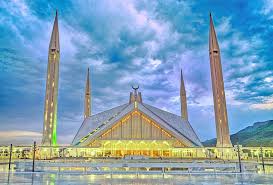A Symbol of Faith and Architecture
The King Faisal Mosque stands as one of the most iconic landmarks of the Islamic world. Known for its breathtaking architecture and spiritual presence, this mosque is not just a place of worship but also a cultural and architectural wonder. It embodies faith, unity, and artistic expression, attracting millions of visitors and worshippers every year.
What makes the King Faisal Mosque truly unique is its ability to blend modern architectural designs with traditional Islamic styles. Its grandeur reflects the vision of leaders who wanted to create a space that symbolized both devotion to God and the progress of modern Muslim society.
The Vision Behind the Mosque
The mosque is named after King Faisal bin Abdulaziz Al Saud of Saudi Arabia, who played a pivotal role in its establishment. His vision was to build a mosque that would not only serve as a central point of prayer but also as a beacon of unity among Muslims worldwide. With his generous contribution and support, the dream of creating one of the largest mosques in the region became a reality.

This initiative highlighted the importance of collaboration and faith. It was not simply about creating a building but about laying down a foundation of togetherness, reminding future generations of the shared heritage and spiritual values that unite people across borders.
Architectural Grandeur
The King Faisal Mosque is a masterpiece of design, fusing tradition with modernism. Its structure is marked by sharp geometric lines, wide open courtyards, and towering minarets that dominate the skyline. The architects aimed to capture both strength and simplicity, ensuring that the mosque reflects humility in worship while also standing tall as a representation of Islamic power and pride.


Inside, the vast prayer hall can accommodate thousands of worshippers at once. The high ceilings, adorned with beautiful chandeliers, and the intricate calligraphy on the walls create an atmosphere of deep reverence. Every element of the mosque’s design, from the patterned tiles to the expansive domes, carries symbolic meaning tied to the Islamic faith.
A Hub for Worship and Community
Beyond being an architectural wonder, the King Faisal Mosque plays a vital role in the daily lives of countless people. Five times a day, the call to prayer echoes through its minarets, inviting Muslims to gather for worship. The mosque has the capacity to welcome huge congregations, especially during Friday prayers and special religious occasions like Eid.
It is not just a place for prayer but also a gathering point where people come together to reflect, share knowledge, and strengthen community bonds. Religious scholars often hold discussions and sermons here, making it a hub for spiritual and intellectual growth.
Global Significance
The King Faisal Mosque is not only admired by local communities but also by people around the world. Pilgrims, tourists, and scholars travel from different countries to witness its beauty and immerse themselves in the spiritual atmosphere it provides. For many, visiting the mosque becomes a life-changing experience, as it offers a moment of peace, humility, and reflection amidst the grandeur of its design.
Its significance extends beyond faith. The mosque has become a cultural landmark that represents a bridge between different civilizations. By welcoming visitors of all backgrounds, it reflects the universal message of Islam—peace, unity, and compassion.
Educational and Cultural Role
One of the most important aspects of the King Faisal Mosque is its contribution to learning. The mosque often serves as a venue for Quranic studies, lectures, and cultural events. It encourages the younger generation to engage with their faith, while also providing a space for broader educational discussions.
By hosting cultural events, the mosque allows people to appreciate Islamic art, history, and heritage. This role transforms the mosque from a simple place of worship into a vibrant cultural and intellectual center.
The Experience of Visiting
Stepping into the mosque is a journey in itself. Visitors are struck by the sheer scale of the building, the tranquility within its walls, and the warmth of its atmosphere. The wide courtyards create a sense of openness, while the peaceful gardens surrounding the mosque add to its serene character.

For many, the most memorable moment is standing beneath the central dome, where light filters in softly, highlighting the intricate patterns and creating a feeling of divine presence. Whether one is there for prayer or simply to admire the architecture, the experience leaves a lasting impression of awe and peace.
A Testament to Unity
King Faisal Mosque is more than a structure of stone and marble. It is a living testament to the power of unity and shared faith. The mosque continues to inspire millions of people, reminding them of the strength that comes from togetherness and belief in a higher purpose.
As generations come and go, the mosque will continue to stand tall, carrying forward its legacy of devotion, architecture, and cultural significance. It is not just a landmark, but a symbol of timeless values that resonate across nations and communities.
Conclusion
The King Faisal Mosque remains one of the most remarkable spiritual and cultural landmarks in the Islamic world. From its visionary origins to its role as a center of worship and learning, the mosque represents faith, unity, and progress. Its majestic design and powerful presence make it a place that inspires awe and reverence, not only among Muslims but among all who visit.
To step into the mosque is to step into history, spirituality, and beauty. It continues to shine as a source of hope, strength, and inspiration, proving that faith and unity can create wonders that stand the test of time.
Do follow UAE Stories on Instagram.
7 Delicious Kunafa Spots in Dubai and Abu Dhabi to Treat Your Kids Before School Starts















